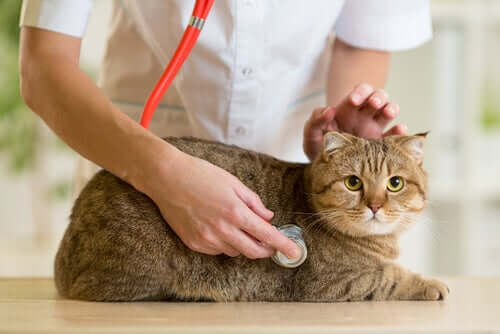Tips to Make Cat Vet Visits Less Stressful


Written and verified by the lawyer Francisco María García
Cats, unlike dogs, aren’t likely to leave their homes. Cat owners often become anxious, as much as the animals themselves, when cat vet visits come along.
But don’t worry! There are some very useful tips to make cat vet visits less stressful. To ensure that taking your cat to the vet isn’t a horrifying situation, follow the tips we share below.
Cat vet visits: mission impossible?
First of all, you have to stay calm at all times. Cats easily detect when their owners are nervous, which can make them equally restless.
You should have a cat carrier to transport your cat. When it comes to purchasing the right model, experts recommend owners to keep practicality in mind. Cat carriers with front doors are much better options. The ones that can be opened from the top are also practical.

“Fighting” with your cat to get it into its carrier isn’t the ideal scenario. You should make sure that the animal naturally acquaints itself with the cat carrier, and even accepts it as its own. To do this, you should leave the cat carrier open in a room where the cat likes to sleep. If your cat shows resistance or indifference, you can put some of their toys inside it, or even food.
Once the cat enters and exits the carrier on its own, the following step is to take small walks around the house with your cat inside its carrier. Some cats even sleep inside their carriers.
If you have enough time for this adaptation process, you may even try talking walks out on the street and then move on to car rides.
On the same day of the vet visit, you can spray the cat carrier with pheromones 30 minutes before the scheduled departure time. This makes cat vet visits less stressful.
Carrying your cat in your arms to the vet is a bad idea
If you don’t have a carrier for cat vet visits, carrying your cat in your arms isn’t the best idea. While some cats stay calm when they’re in their owners’ arms, in general, cats tend to go crazy when they feel threatened or something frightens them.
A sports bag may be a good option, preferably those with holes or made of nylon. This way, the animal can see the outside world, and, most importantly, breathe easily.
The bottom of the bag should be rigid. This is because it’ll even be more uncomfortable for the cat to travel inside a bag that doesn’t even allow it to stand.
Getting used to car rides
If the vet’s clinic isn’t just a short walk away from home, your cat should become used to car rides.
When it comes to taking your cat to the vet in your car, it’s a good idea to keep outside noises out. In this regard, it’s also essential to ensure that your vehicle is well-ventilated, especially during the summer.

If you don’t have your own car, you can use public transportation for cat vet visits. In these cases, it’s necessary to adapt your cat to public transportation, surface or underground.
In the waiting room
Most of the time, you have to wait a while at the clinic before the vet can see your cat. During this period, cat owners should be aware that, although their cats may not show it, they will be uneasy.
Your cat should always wait inside its carrier (or bag), placed on your lap. You should talk to your cat frequently and caress it (only if there’s enough space to put your hand inside the carrier or bag without the risk of the animal escaping).
If your cat has to wait along with dogs, the situation can become tense. In this case, it’s best to put your cat with its back to the waiting room and avoid, if possible, dogs coming to sniff its carrier.
When your cat returns home
If your cat lives with other animals of the same species, your other cats may act strange around the newcomer. This is because the cat’s smell changed during the vet visit. Thus, patience is key.
This text is provided for informational purposes only and does not replace consultation with a professional. If in doubt, consult your specialist.